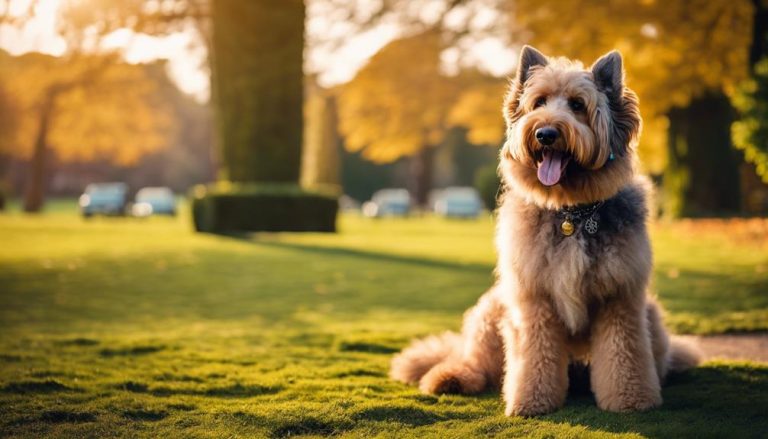Shepadoodle: Intelligent, Loyal Crossbreed Dog
The Shepadoodle is a unique mix that brings together the smartness of the Poodle and the loyalty of the German Shepherd. This blend was first developed in the 1960s for military use, creating a dog that’s not only smart but also versatile, capable of performing various roles including service, therapy, and as family pets. They are medium to large dogs, weighing between 50-90 pounds and standing 22-28 inches tall. Their coat can be grey, brown, white, tan, or black and needs regular grooming because it can vary from one dog to another.
These dogs are very intelligent, which makes them quite easy to train. They also have a protective nature, thanks to their German Shepherd heritage. Breeders have worked to bring out the Poodle’s characteristic of minimal shedding in Shepadoodles. This makes them a great choice for families or individuals looking for a capable and adaptable dog that can take on complex tasks with ease.
Key Takeaways
- Shepadoodles mix Poodle smarts and German Shepherd loyalty.
- They’re big, 50-90 pounds, perfect for any home role.
- Needs: grooming, active play, smart training.
Quick Facts
Shepadoodles are a unique mix of German Shepherds and Poodles, known for their varied looks and a lifespan of about 10-13 years. These dogs blend the smartness and flexibility of their parent breeds, making them quite easy to train. A Shepadoodle might weigh anywhere from 60-90 pounds and have a height of 22-28 inches, showing off a strong and agile physique that thrives on both physical and mental challenges.
Their coat might be curly, wavy, or straight and dense, a mix of the Poodle’s allergy-friendly fur and the German Shepherd’s thick coat. This means their grooming needs can vary widely. Despite not being recognized by the big dog clubs, Shepadoodles are becoming more popular. They’re great for various roles like service, therapy, or just being a loving pet. Their eagerness to learn and to please makes them perfect for early and advanced training.
Overview
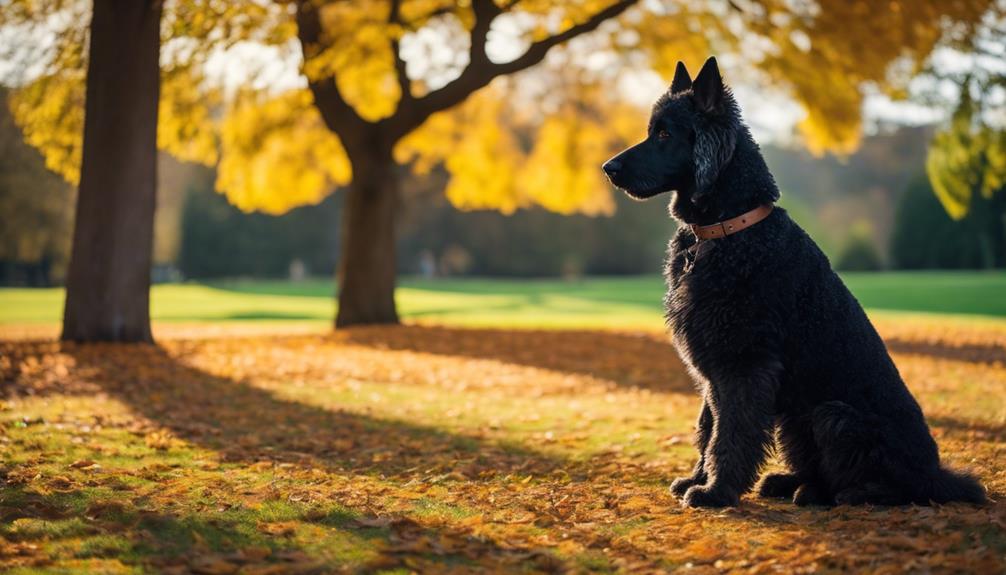
The Shepadoodle is a unique crossbreed that combines the smartness of German Shepherds with the Poodle’s allergy-friendly coat. This mix creates a great option for those looking for a smart, trainable pet that fits well into various lifestyles. With traits inherited from both the German Shepherd and Poodle, Shepadoodles bring together the best of both worlds.
These dogs are medium to large in size, typically weighing in at 50-90 pounds and standing tall at 22-28 inches. They have a strong, agile build that’s perfect for numerous activities. Their life expectancy ranges between 10 to 18 years, and they come in a variety of coat colors like grey, brown, white, tan, and black, making them not only lifelong companions but also attractive ones.
Shepadoodles are known for their intelligence and ease of training. Their unique look and low-shedding coat make them stand out as ideal pets for active households that want a dog that’s both loyal and easy to train. To make the most of their abilities, it’s crucial to invest time in proper training and socialization from an early age.
In short, the Shepadoodle is a fantastic choice for families or individuals seeking a pet that’s both smart and friendly, while also being kind to those with allergies. Their adaptability and eagerness to learn make them suitable for a variety of homes, proving that this breed can be a wonderful addition to your family.
Intelligent and Family-Friendly
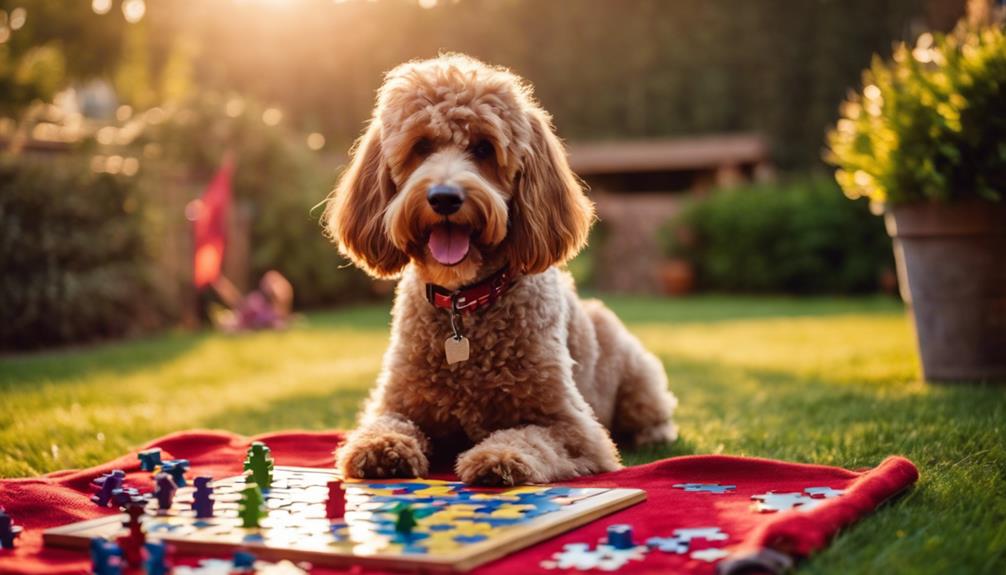
Shepadoodles are known for their quick learning abilities and their desire to make their owners happy, making them perfect for families. They’re not just smart; they also have a deep connection with the emotional well-being of their family members, making them the ideal companion. This blend of intelligence and gentleness, especially around children, makes Shepadoodles a great choice for any household.
To help them reach their full potential, it’s important to start training and socializing them from an early age. Activities that challenge their minds and introduce them to new people and animals help them become well-rounded and friendly dogs. Here’s a table that breaks down the benefits of having a Shepadoodle as part of the family:
| Aspect | Importance |
|---|---|
| Learning Ability | Makes training easier and helps them fit into family life quickly. |
| Eagerness to Please | Creates a strong connection between the dog and its owners, leading to a more peaceful home. |
| Respectful with Children | Makes them safe and fun companions for kids. |
| Need for Mental Stimulation | Encourages activities that keep both the dog and its family active and happy. |
With the right training and socialization, Shepadoodles can become faithful and obedient pets, bringing joy to their families.
Origins: 1960s Military Experiment

The Shepadoodle has its roots in the 1960s, born from a military experiment. This blend of German Shepherd and Poodle was crafted to bring the best of both breeds into a single canine capable of performing various military and service tasks. The goal was clear: to create a dog breed that excelled in military operations.
The project had specific aims. It sought to engineer a versatile working dog, one that could handle everything from security to support with ease. During the 1960s, the breeding program focused on merging the genetic strengths of both the German Shepherd and the Poodle to achieve peak performance. The result was a breed known not just for its physical strength but also for its sharp intelligence. This made the Shepadoodle highly adaptable, ready to tackle a range of service roles with efficiency.
In creating the Shepadoodle, the military aimed to harness the best attributes of both parent breeds. This effort was part of a broader initiative to develop dogs that could meet the demanding requirements of military work. The Shepadoodle stood out as a prime example of this endeavor, combining the German Shepherd’s loyalty and discipline with the Poodle’s smart and hypoallergenic coat. This crossbreed was designed to be more than just a working dog; it was meant to excel in various tasks, proving valuable in both military and service contexts.
Military Breeding Goals
In the 1960s, the military embarked on an experiment to create a dog breed that combined the best characteristics of the German Shepherd and the Poodle. This effort resulted in the creation of the Shepadoodle, a dog breed designed for military use. The goal was to combine the loyalty and strength of the German Shepherd with the intelligence and agility of the Poodle.
This breed was expected to be highly trainable, adaptable, and hardworking, making it perfect for a range of military tasks such as tracking, protection, and search and rescue operations. The Shepadoodle was aimed to embody the ideal traits of its parent breeds to meet the high demands of military work.
Initial Hybrid Purpose
In the 1960s, the military sought to create a dog breed that combined the best traits of the German Shepherd and the Poodle. They aimed for a dog that was both smart and loyal, good for various tasks. The Shepadoodle was born from this idea, combining the German Shepherd’s protective nature with the Poodle’s intelligence. This mix was meant to make a dog perfect for military police work, thanks to its quick learning and agility.
The crossbreed was a strategy to get a dog that could do specific jobs really well. With the German Shepherd’s strength and the Poodle’s history as an efficient water dog in Germany, the Shepadoodle was expected to excel in many roles. This breed showed that by carefully choosing certain qualities from two different breeds, it’s possible to create dogs that are not only versatile but also highly effective in performing tasks.
1960s Breed Development
In the 1960s, an innovative breeding program was launched with the aim of creating a dog that could excel in military duties. This program brought together the German Shepherd and the Poodle, two breeds known for their distinct qualities.
The German Shepherd was chosen for its unwavering loyalty and robustness, while the Poodle was selected for its sharp intelligence and hypoallergenic coat. The combination aimed to produce a dog that was not only smart and easy to train but also physically capable and less likely to cause allergic reactions among the handlers.
This endeavor resulted in the birth of the Shepadoodle, a hybrid breed that ideally encapsulated the best features of its parent breeds. These dogs were specifically designed to serve as military police dogs for the US Army, excelling in roles that required agility, a trainable nature, and a protective demeanor.
The Shepadoodle stood out as a bespoke creation, embodying a perfect mix of physical prowess and mental acuity, tailored for the diverse demands of military service.
Medium to Large Breed
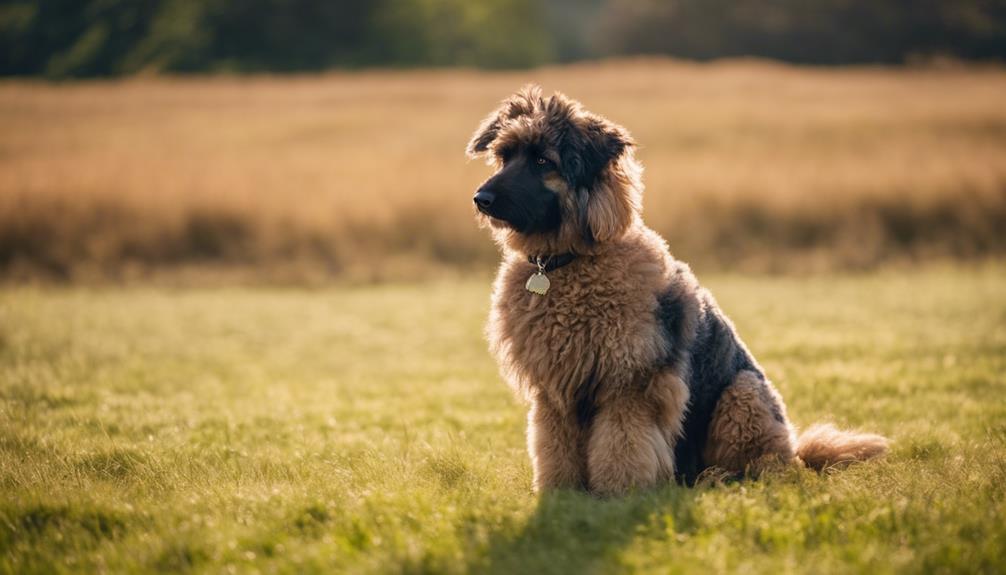
Understanding the Shepadoodle’s place as a medium to large breed is crucial for anyone thinking of bringing one into their home. This size has a big impact on their health and happiness. We’ll cover key points like what their size means for their lifestyle, how much exercise they need, the types of homes that are best for them, and what to expect from their personality and grooming routine.
Size Implications: The size of a Shepadoodle affects what they eat, how much room they need, and certain health issues they might face.
Physical Activity Needs: Shepadoodles are active and need plenty of exercise to stay healthy and avoid getting into trouble.
Ideal Living Conditions: We’ll look at how well they adapt to different living situations, taking into account their physical size and need for activity.
Behavioral Characteristics: Understanding how a Shepadoodle’s size influences its behavior helps in fostering positive interactions with people and other pets.
Size Considerations
Shepadoodles stand out as a mix between medium and large dog breeds, with their height ranging from 22 to 28 inches and their weight falling between 50 and 90 pounds. They make perfect pets for active families due to their size and energy levels, inheriting traits from both German Shepherds and Poodles.
These dogs combine the best of both worlds: the German Shepherd’s strength and protective nature, and the Poodle’s smart brain and low-shedding coat. This mix not only affects their physical looks, which can vary in colors like grey, brown, white, tan, and black, but it also plays a significant role in their health and happiness.
It’s critical to give them the right food that suits their size to support their growth and help them live a long life, which can be anywhere from 10 to 18 years. Given their strong build and high energy, Shepadoodles need plenty of exercise. This highlights the need for their owners to lead an active lifestyle to keep up with them.
Exercise Requirements
Shepadoodles, known for falling into the medium to large dog breed category, need a good deal of exercise to stay healthy and behave well. They are pretty energetic, requiring around 12 miles of exercise every week to keep them in top shape. This could mean taking them for runs, long walks, playing fetch, or having them participate in training activities that challenge them both physically and mentally.
Not giving Shepadoodles enough exercise can lead to weight gain and might cause them to act out, especially if they’re left by themselves for too long. Making sure they get regular and varied physical activities is key to their well-being. It helps keep them fit and their behavior in check.
Suitable Living Spaces
Shepadoodles, a cross between German Shepherds and Poodles, are energetic and large dogs that thrive in environments with plenty of room. They’re smart and active, making them a poor fit for small apartments.
They do best in homes with fenced yards where they can run, play, and stay healthy. Without enough space, they might develop behavioral problems due to lack of exercise.
Their love for activities like running, hiking, and swimming, coupled with their tendency to bark, means they need a spacious home. This ensures they can live happily and fit well into a family setting.
Temperament Traits
Exploring the right living environments for Shepadoodles leads us to discover their unique temperament traits, stemming from their German Shepherd and Poodle ancestry. These dogs are smart, athletic, and easy to train, inheriting the best from both sides. They form deep connections with their families, showing how loyal they can be. This loyalty is matched with a friendly nature, making them perfect pets who love being around people and receiving affection.
Their protective instincts are strong, a characteristic likely inherited from the German Shepherd side, making them excellent watchdogs. Yet, their personalities can differ, requiring an owner who understands the importance of keeping them mentally and physically engaged. This helps prevent the negative impact of being left alone too much.
Grooming Needs
To keep a Shepadoodle’s coat looking its best and support their hygiene, it’s key to have a regular grooming routine. Brushing their coat about three times a week helps avoid mats and tangles that can damage their fur. It’s also critical to check and clean their ears often to prevent infections, which plays a big role in their overall health.
Trimming their nails regularly helps keep their paws in good shape and stops them from experiencing discomfort due to long nails. Dental care is another important aspect, involving brushing their teeth regularly and giving them dental chews to help fight off oral diseases. Together, these steps form a comprehensive grooming plan that keeps them healthy and clean.
Loyal and Protective Nature

The Shepadoodle’s loyalty and protective nature come from both their genes and the way they’re raised, making them perfect for those looking for a reliable pet. Understanding why they’re so protective involves looking at several aspects of their behavior.
Guarding Instincts are a big part of what makes Shepadoodles great protectors. Their mix of genetics gives them a strong sense of when to be on guard. Family Bonding is crucial, too. These dogs form tight-knit relationships with their families, which fuels their desire to protect. Analyzing their Protective Behavior shows us how they react to potential threats, always ready to stand between danger and their loved ones. Their Alertness is another key trait; Shepadoodles are always watching and listening for anything out of the ordinary.
These characteristics don’t just happen. A Shepadoodle’s environment plays a big role in shaping their protective behaviors. For families and individuals looking for a dog that’s both a loving companion and a vigilant guardian, understanding these traits is essential.
Guarding Instincts
Shepadoodles, a mix of German Shepherd and Poodle, are naturally protective of their families and homes. This trait comes from their German Shepherd ancestors and shows up as a strong loyalty and a desire to keep their loved ones safe. These dogs are always on alert, making them great watchdogs. They are quick to let their owners know if something seems off, ready to act if they feel their family is in danger.
Socialization and training are key to ensuring that a Shepadoodle’s protective instincts are under control. With the right guidance, these dogs can be both loving family pets and reliable guardians. They’re perfect for anyone looking for a faithful and attentive companion.
In today’s world, where safety and companionship are highly valued, Shepadoodles offer the best of both. Their innate guarding instincts, combined with their affectionate nature, make them a top choice for families. Remember, consistent training and socialization are vital to help them understand when to guard and when to relax, ensuring they fit seamlessly into their family roles.
Family Bonding Dynamics
Shepadoodles naturally take on the role of both guardians and loving family members because of their protective instincts. They are deeply loyal and always keep a close watch over their families, which strengthens the bond between them.
This breed is also very in tune with how their human family members feel, offering comfort and support when it’s needed most. Their caring and committed nature not only makes the family bond stronger but also cements their place as essential members of the household.
The Shepadoodle’s mix of guardianship and emotional connection makes them more than just pets; they’re true companions and protectors.
Protective Behavior Analysis
Shepadoodles inherit a strong sense of loyalty and protection from their German Shepherd ancestors, making them excellent family pets and guard dogs. They naturally form close attachments to their human families, leading to a protective stance around them.
Shepadoodles are cautious around strangers, making them great at warning their owners about unknown visitors or potential threats. It’s crucial to train and socialize them well to ensure their protective nature is displayed positively, avoiding aggression and creating a safe atmosphere for everyone involved.
Alertness and Vigilance
Shepadoodles inherit their sharp alertness and vigilance from their German Shepherd lineage, known for being excellent watchdogs. This makes them great protectors of their families, always keeping an eye out for anything unusual. They are quick to notice and respond to potential dangers, proving themselves as reliable companions.
Through proper training and socialization, Shepadoodles can hone their protective instincts. This not only makes them well-mannered but also ensures they are dependable family members. Their loyalty and natural watchfulness position Shepadoodles as outstanding guardians and cherished pets.
Training for Protection
Shepadoodles have a natural instinct to protect, thanks to their German Shepherd heritage. It’s crucial they get the right training to use this instinct in a helpful way. This involves teaching them to recognize who is a friend and who might be a threat. Positive training methods work best, rewarding them for alerting to strange noises or activity. This way, they help keep homes safe without becoming aggressive.
Training also teaches Shepadoodles how to act when their protective skills are truly needed. Regular practice and clear rules make sure they only act out of protection when necessary. This creates a safe environment for everyone, making Shepadoodles great companions. Their training ensures they react calmly and appropriately to danger.
Genetic Conditions Risk

The health of Shepadoodle dogs involves understanding the potential genetic issues they might face. Being proactive about these health concerns helps in reducing the chance of genetic diseases. Learning about the common health problems and taking steps to prevent them is key for the longevity and happiness of these dogs.
1. Common Health Problems
2. Preventive Health Actions
3. Analysis of Genetic Disorders
4. Ethical Breeding Practices
Caring for Shepadoodle dogs means being aware of their genetic predispositions to certain conditions. With the right knowledge, steps can be taken to prevent these issues, ensuring a healthier life for them. It’s about knowing what these dogs might face health-wise and how to support them.
Responsible breeding is also crucial. It ensures puppies are less likely to inherit serious conditions. This involves breeders being thorough in health screenings and choosing breeding pairs wisely to reduce the risk of health problems in puppies.
Identifying Common Disorders
Knowing about the genetic risks in Shepadoodles is key to spotting issues like hip dysplasia, degenerative myelopathy, hemophilia, and panosteitis. These conditions can seriously affect their health and ability to move. Catching these problems early through regular vet visits is crucial for effective management.
Hip dysplasia is especially common in Shepadoodles due to their large size and genetic makeup. This problem occurs when the hip joint doesn’t form properly, which can lead to pain or difficulty walking if not treated. Keeping an eye out for symptoms of these conditions is vital for keeping Shepadoodles healthy.
Preventative Health Measures
Understanding the genetic health risks that Shepadoodles may face is crucial for their well-being. These dogs can inherit conditions like hip dysplasia, degenerative myelopathy, hemophilia, and panosteitis. Knowing about these risks helps owners take steps to protect their pets’ health.
Taking your Shepadoodle for regular veterinary check-ups is key to catching and treating health issues early. This can lead to better health outcomes and a higher quality of life for your dog. Caring for your pet also involves grooming them regularly, keeping their teeth clean, and feeding them a well-balanced diet. These steps are important in reducing the likelihood of genetic health problems in Shepadoodles.
Inherited Conditions Analysis
Shepadoodles, a mix between German Shepherds and Poodles, often face inherited health issues like hip dysplasia, degenerative myelopathy, hemophilia, and panosteitis. These conditions stress the need for owners to stay alert and provide continuous health care. Regular vet visits are crucial for catching and managing these problems early.
Understanding these genetic risks is key for owners to head off potential health troubles, ensuring their dogs live happier, healthier lives. Through informed care, Shepadoodle owners can make a big difference in their pets’ quality of life.
Grooming Needs
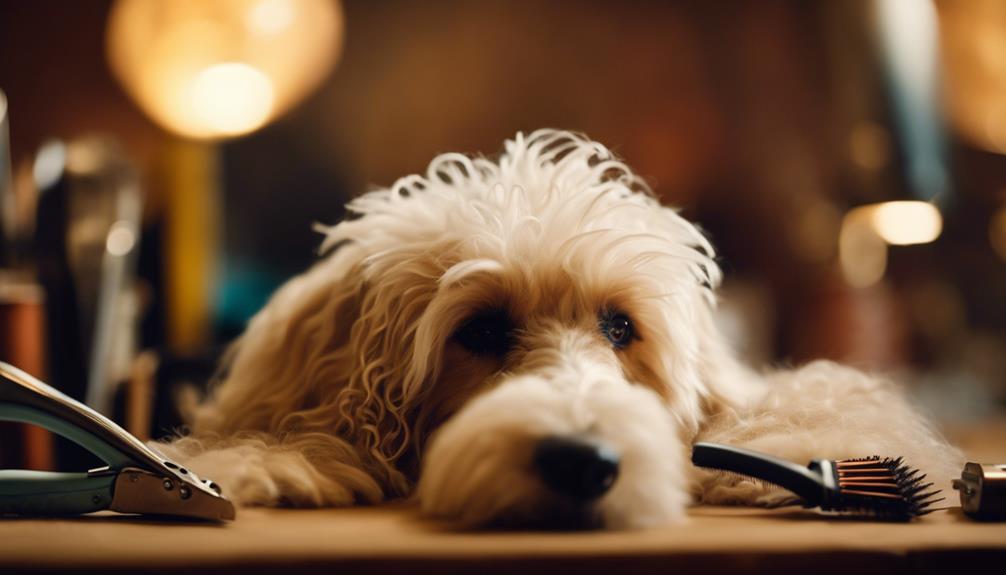
Shepadoodles have specific grooming needs that are crucial for their health and appearance. Their unique coat requires a tailored approach to ensure they stay healthy and look their best. This involves regular brushing, baths, and using the right tools for their hypoallergenic fur.
Understanding the coat type and length of a Shepadoodle is the first step to proper grooming. This knowledge helps in choosing the right methods and tools for their care. Routine brushing is a must to avoid mats and tangles in their fur. It’s not just about keeping them looking good, but also about preventing skin issues that can arise from neglected coats.
Finding the right bathing frequency is also key. Too many baths can dry out their skin, but too few can lead to dirt build-up and smell. It’s about striking a balance that keeps their coat in good condition without harming their skin.
Despite their hypoallergenic label, Shepadoodles do shed. Having a strategy for shedding management is essential. This includes choosing grooming tools that effectively remove loose fur without irritating their skin.
Proper grooming is more than just a beauty routine for Shepadoodles. It’s about keeping them comfortable, healthy, and happy. With the right care, these dogs can maintain their charming appearance and well-being.
Coat Type & Length
Knowing the coat type and length of Shepadoodles is crucial for understanding how to groom them properly. Their coats can vary widely, from curly like a Poodle’s to straight like a German Shepherd’s. This variation affects how much grooming they will need.
Shepadoodles with curly coats need careful grooming to prevent matting and tangling. This kind of coat traps dirt and debris more easily and can lead to skin issues if not maintained. Straight-coated Shepadoodles might not need as much grooming, but they still require regular care to keep their fur clean and healthy.
It’s important to match your grooming routine to your dog’s specific needs. This means regular brushing for those with curly coats and perhaps less frequent grooming for those with straighter coats. Understanding your Shepadoodle’s coat type helps keep them comfortable and looking their best.
Regular Brushing Essential
Regular brushing is crucial for Shepadoodles, helping to avoid matting and spreading their skin’s natural oils across their fur. This routine does more than just keep them looking good; it’s key for their health too. When you brush your dog regularly, you prevent painful knots and can catch any skin issues early on.
Brushing also means less hair around the house since it captures loose fur. Sometimes, a trip to a professional groomer is needed for the best coat health. This highlights the importance of keeping up with your Shepadoodle’s coat care.
Bathing Frequency Tips
Finding the right bathing schedule for Shepadoodles is crucial to keep their coat healthy and clean. Generally, bathing them every 6 to 8 weeks works well. This helps preserve the natural oils in their skin, which are vital for keeping it moisturized. If your Shepadoodle is more active or spends a lot of time outdoors, you might need to bathe them more often. On the other hand, washing them too frequently can strip away these oils, leading to dryness and irritation.
Choosing a mild dog shampoo designed for sensitive skin can prevent any adverse effects on your pet’s coat and skin health. Between baths, regular brushing is beneficial. It not only minimizes shedding but also keeps their coat smooth and free of tangles. This practice will ensure your Shepadoodle’s fur remains healthy and lustrous.
Shedding Management Strategies
To manage shedding in Shepadoodles effectively, a comprehensive approach is necessary. This includes regular brushing, visits to a professional groomer, and some trimming when needed. Shepadoodles that lean more towards their Poodle heritage tend to shed less, thanks to the hypoallergenic traits they inherit. Hence, establishing a grooming routine is essential.
Brushing their coat about three times a week is a good practice. It helps untangle their hair and removes dead fur, significantly controlling shedding. This practice not only keeps their coat neat but also healthy. Taking your Shepadoodle for professional grooming sessions also plays a big part in keeping their coat in top shape. Trimming their fur occasionally helps keep it manageable and reduces shedding further. Staying consistent with these grooming habits is key to keeping their coat looking and feeling great.
Special Grooming Tools
Maintaining a regular grooming routine is crucial for Shepadoodles, given their distinct coat types. To manage their fur effectively, you’ll need a variety of specialized grooming tools. Slicker brushes, combs, and dematting tools are key for untangling fur and keeping it smooth. Clippers are necessary for trimming and shaping the coat accurately.
For Shepadoodles with curly fur, using detangling sprays or conditioners is a smart move. These products help prevent mats and knots, making the coat easier to manage and look its best. Investing in high-quality grooming tools, like professional scissors and clippers, can make the grooming process smoother and more enjoyable for both you and your pet.
Dietary Requirements
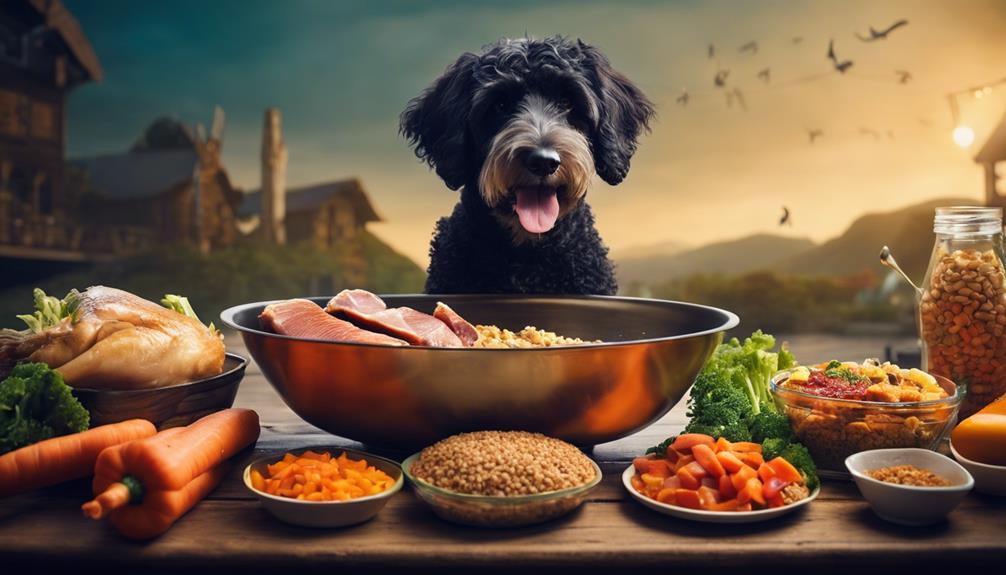
Ensuring the health and longevity of Shepadoodles begins with understanding their dietary needs. In this guide, we’ll cover the essentials of feeding Shepadoodles, from high-quality protein sources to the importance of fruits and vegetables. We’ll also talk about what foods to avoid to keep your dog safe.
Ideal Food Choices: Finding the right food for Shepadoodles is key. They thrive on diets rich in protein, with added fruits and vegetables for vitamins.
Feeding Portions: It’s essential to feed Shepadoodles the right amount. Too much food can lead to obesity, while too little can affect their energy.
Nutritional Essentials: Shepadoodles have specific dietary needs that support their active lifestyle. A balanced diet is critical for their overall health.
Toxic Foods to Avoid: Certain foods are harmful to Shepadoodles. Knowing what these are can prevent health issues.
Caring for Shepadoodles means providing them with a diet that meets their nutritional demands. High-quality dog food that’s rich in protein, along with a mix of fruits and vegetables, sets the foundation for a healthy diet. However, it’s equally important to know how much to feed them to maintain a healthy weight and energy level.
Furthermore, being aware of toxic foods and keeping them out of your Shepadoodle’s diet is vital. This understanding ensures your pet stays healthy and happy.
Optimal Food Choices
To keep shepadoodles in top health, they need a diet that’s packed with high-quality proteins. These large, active dogs thrive on meals that are filled with real meat or fish. Such ingredients are key for keeping their muscles strong and their energy levels up. It’s also smart to skip foods that use fillers or by-products, as these can cause stomach issues and don’t really provide any nutritional benefits.
Including whole grains, veggies, and fruits in their meals is a great way to add essential vitamins, minerals, and fiber. This helps not just with their digestion but also boosts their overall health. Always talk to a vet to create a diet that’s just right for your shepadoodle, making sure they get everything they need for a happy, healthy life.
Portion Control Guidelines
Portion control is essential for maintaining a Shepadoodle’s health because it prevents them from gaining too much weight. This breed, a mix between a German Shepherd and a Poodle, should eat about 2-3 cups of high-quality dry food each day. Splitting their daily food intake into two meals helps avoid the risk of overeating and obesity. Treats should only make up a small fraction of their diet to keep calorie intake in check.
Monitoring their weight is crucial, and adjusting their food amount based on their body condition is necessary to keep them in top shape. For any Shepadoodle, considering factors such as age, weight, and activity level is key to determining the right food portion. Always talk to a vet to get advice tailored to your dog’s specific needs.
Nutritional Needs Overview
After talking about how much food Shepadoodles should eat, let’s look at what kind of food is best for them. Shepadoodles come from German Shepherds and Poodles, so they need high-quality dog food that’s full of protein. This helps them build strong muscles, a trait seen in both of their parent breeds.
Watching how much they eat is important to avoid obesity, which can be a problem for them. Adding different fruits and vegetables to their diet gives them important vitamins, minerals, and fiber.
It’s a good idea to work with a vet to make sure their diet fits their specific needs, like how old they are, how big they are, and how active they are.
Frequently Asked Questions
What Is the Temperament of a Shepadoodle?
- Shepadoodles require consistent training.
- Exercise and socialization keep them happy.
- Great for family life with proper care.
Is a Shepadoodle a Good Guard Dog?
- Training ensures the dog stays sharp and obedient.
- Regular exercise keeps the dog fit for protection duties.
- Health checks ensure the dog is always ready to guard.
How Much Do Shepherd Doodles Cost?
- Shepherd doodles cost between $1,000 and $3,000.
- Ownership costs include healthcare, grooming, and food.
- Plan finances before buying a shepherd doodle.
What Is a Shepadoodle Mixed With?
- Shepadoodles blend German Shepherds and Poodles.
- Care includes health awareness, tailored exercise, and training.
- They are perfect for modern pet lovers seeking a unique mix.

